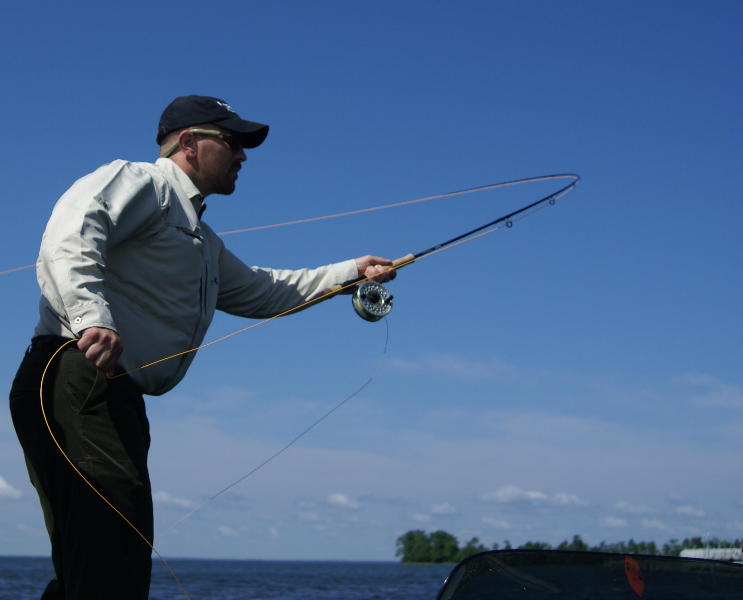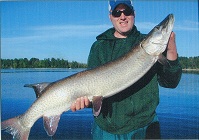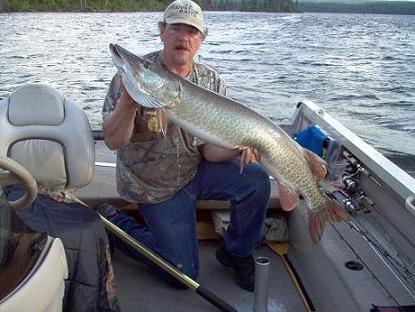|
|
Posts: 52
| I have a 20' Lund ProGuide Tiller, 175 Merc with power steering. What it is best/safest method to running in big waves or big rollers or a combination of both? Trim motor up or down, angle into the waves, just wonder what you guys do, to be able to run, but be safe. Thanks. | |
| | |

Posts: 1663
Location: Kodiak, AK | With a proper deep V hull, you can let the hull work for you. First, in a chop, say 2'ers, head into the waves and let the bow and the weight of the boat (full tank of gas) work for you to cut the waves. I this, I'll trim down to get the V into the wave. I don't mean trim down too far and plow into the waves, but if you get the V up too high, the keel starts to work and that's not the keel's job. Heading up-swell in rollers, I'll also trim down because each time you come up from a trough, that's basically a hole shot with acceleration and you'll want prop in the water. Watch your power here because you can launch off a roller.
Heading down-swell, watch the power (not too much or you can get in serious trouble if you spear the back of a wave) and trim up some to keep the bow higher and land more on the keel and avoid spearing the back of a swell. Chop isn't as bad, but you can still dive a boat if you're really hauling, have power and hit it right.
I like heading into chop so I can pick my battles, setlle the trim and just go. Trying to go diagonal across it like you often hear, you're constantly adjusting, accelerating, slowing, and things are coming at you from the side, instead of in front of you. And this applies for V hulls. A deeper hull is more of a pain in a side or diagonal approach. Try the head-on thing in too big of seas in a bass hull and you'll have a rougher ride. In a bass hull in heavy seas, you'll be using a whole 'nother set of tactics to get home dry.
This is my technique. Don't take is as official guidance on driving a boat. But I run big water pretty much exclusively and I've never gotten myself in trouble yet!
Edited by esoxfly 3/20/2016 7:55 PM
| |
| | |
Posts: 1023
| I always trim down a bit and try to find a speed where I can get the smoothest ride. Unfortunately on St Clair in my 16'er that's often pretty slow. | |
| | |

Posts: 1276
Location: Walker, MN | Yep, I run straight into waves, or run the troughs (slightly downwind) whenever possible. Often on really big rollers, throttle applied when coming down a wave (it seems suicidal at first) can lift the bow, avoiding spearing the next one. Playing with the throttle definitely seems to be the key. | |
| | |

Posts: 1396
| I've had two ProV tillers (an '88 and a '98) and now have an '08 ProGuide 1825. Only had the ProGuide for a couple of years and haven't had it in anything too nasty yet, as I haven't been doing much walleye fishing anymore. I did have my ProVs in nasty stuff quite frequently. If you are going straight downwind or straight upwind, you can pretty much do what you want until you start banging the waves. If the waves are big enough that you start hammering them, I just suggest patience, and slow down. If you need to angle to get to where you are going, downwind you can usually angle OK, but to keep from getting soaked going upwind, I would tack, by going directly into the wind, and then slowing down and go perpendicular to the wind for a while, and the back directly into the wind again. In the really big stuff (when you can't see over the waves when your in a trough), I recommend simply riding the back of a wave and avoid getting into a trough at all. You need to stay active on the throttle, revving it to stay up on the wave, and backing off to prevent from dropping into the trough in front of you. Of course, when it is this bad, we really shouldn't be out there anyway, but sometimes you get caught. As others said, I would keep the trim lower than if you were running up on plane, you want your bow to pop up a bit if you goose the throttle. | |
| | |

Posts: 20255
Location: oswego, il | I have a 1750 crestliner and I can run bigger waves with it. The key is trim and speed. My boat runs well up and down the waves at 18-22mph with a little trim up but not much. They balance your looking for is to not jump or crash a wave. Once they get above 4 then I cannot do it. Slow slow slow. | |
| | |
Posts: 52
| Thanks a lot guys for taking the time to talk about this. Trust me, I will use everybody ideas!! Thanks.
| |
| | |

Posts: 271
Location: davis,IL | The responses here sound about right. When running a cross chop I'll tac ( into the waves then turn and go with the waves) the waves kind of like a sailboat would instead of just running a straight line, takes alittle longer zig zagging like that, but usually is not as brutal a ride. | |
| | |
Posts: 1760
Location: new richmond, wi. & isle, mn | Good advice given above. Experience in big water takes some time. Easy on the trim and easy on your speed. Most important, "pay attention". Big waves are not consistent. Keep your eyes ahead. | |
| | |
| yes keep an eye out for the occasional rogue wave. | |
| | |
Location: 31 | When you're on big/rough water you could also consider a smaller pitched prop. Although it's solid advice to slow down, most fishing boats plane out at about 20 MPH, which is also going to be about the best speed to make any kind of time in semi-rough water... you can end up really fighting the throttle with a "correct" size prop.
It's made a huge difference for me. | |
| | |

Location: Eagle Lake Vermilion Bay, Ontario | all the guys above have brought forward important points,patience,throttle,angle,etc all key points however regardless one needs to learn unfortunatly through expereince and the hard way teaches alot quick.
some things i have learned with 25 + yrs of fairly big water.
1. if you're going to spend any amount or % of time on big water then be prepared for it or you might as well just beat yourself over the head with a bat before you leave the dock.
to a point you cant have a big enough boat ,seat ped. shock absorbsion is worth whatever it costs,and an under powered boat going any distance into the fetch of a big wind makes any manuevers mentioned by those above difficult even dangerous with the incredible current that can be created and the wind coming over the top of a rogue wave as your bow crests it.
move passengers to the furthest back seating available,incredible diff. on the beating as well as a much dryer ride. and have everything put away or lashed down or eventually you will lose something.
2. plan your day before hand in regard to wind and how it is predicted to progress,switch,etc through your day
3. use your head, if the option is available work your way to the lee,cross wind lee side,take a path with islands wind breaks,etc. before a long run instead of against it all the way back. i will gladly take my time to run with patience 2-5+ miles out of my way against the wind to get get there and it's like WHEW! ITS A DIFF WORLD!for a much smoother 20-30 min ride home or next more sensible spot. in the end you will not lose much time if any and save you,your equip.,and especially those with you alot of beating.
steve herbeck
AML prop. emeritus,guest fishing instruction coordinator ,master guide,US marketing
facebook.com/AndyMyersLodge , andymyerslodge.com | |
| | |
Posts: 92
| Totally agree M-Ninja, As someone that deals with a south wind on the north end of the big lake every weekend,even with a long boat powering up as you are coming down keeps the deck dry! Especially with the way they are spaced on leech! | |
| | |
Posts: 52
| Thanks again guys!! Lot's of good tactics in your replies. Not much big water for Muskie fishing here in Indiana , but we do go out on Lake Michigan sometimes, and some bigger water up around Hayward Wi. I saw the picture of the fiberglass bass boat swamped on LSC. Not my cup of tea, for sure !! Gotta respect big water for sure. | |
| | |
Location: 31 | Andy Myers Lodge - 3/23/2016 8:46 AM
all the guys above have brought forward important points,patience,throttle,angle,etc all key points however regardless one needs to learn unfortunatly through expereince and the hard way teaches alot quick.
some things i have learned with 25 + yrs of fairly big water.
1. if you're going to spend any amount or % of time on big water then be prepared for it or you might as well just beat yourself over the head with a bat before you leave the dock.
to a point you cant have a big enough boat ,seat ped. shock absorbsion is worth whatever it costs,and an under powered boat going any distance into the fetch of a big wind makes any manuevers mentioned by those above difficult even dangerous with the incredible current that can be created and the wind coming over the top of a rogue wave as your bow crests it.
move passengers to the furthest back seating available,incredible diff. on the beating as well as a much dryer ride. and have everything put away or lashed down or eventually you will lose something.
2. plan your day before hand in regard to wind and how it is predicted to progress,switch,etc through your day
3. use your head, if the option is available work your way to the lee,cross wind lee side,take a path with islands wind breaks,etc. before a long run instead of against it all the way back. i will gladly take my time to run with patience 2-5+ miles out of my way against the wind to get get there and it's like WHEW! ITS A DIFF WORLD!for a much smoother 20-30 min ride home or next more sensible spot. in the end you will not lose much time if any and save you,your equip.,and especially those with you alot of beating.
steve herbeck
AML prop. emeritus,guest fishing instruction coordinator ,master guide,US marketing
facebook.com/AndyMyersLodge , andymyerslodge.com
Great point on going out of your way behind islands or whatever, I also look to drop in behind a large boat as well.
Something that can be easily overlooked is the trolling motor deploying in rough conditions, just a few seconds and an extra bungee cord can help to avoid a dangerous situation.
Attach the kill switch to the personal flotation device you are wearing, and keep a throwable handy.
And yes... I didn't know what I was missing until I got shock absorbing seats; they are almost worth their weight in gold! Safety is definitely job #1 on the water, but not taking a pounding is important too.
| |
| | |

Posts: 1767
Location: Lake Country, Wisconsin | Jerry Newman - 3/24/2016 10:58 AM
Andy Myers Lodge - 3/23/2016 8:46 AM
all the guys above have brought forward important points,patience,throttle,angle,etc all key points however regardless one needs to learn unfortunatly through expereince and the hard way teaches alot quick.
some things i have learned with 25 + yrs of fairly big water.
1. if you're going to spend any amount or % of time on big water then be prepared for it or you might as well just beat yourself over the head with a bat before you leave the dock.
to a point you cant have a big enough boat ,seat ped. shock absorbsion is worth whatever it costs,and an under powered boat going any distance into the fetch of a big wind makes any manuevers mentioned by those above difficult even dangerous with the incredible current that can be created and the wind coming over the top of a rogue wave as your bow crests it.
move passengers to the furthest back seating available,incredible diff. on the beating as well as a much dryer ride. and have everything put away or lashed down or eventually you will lose something.
2. plan your day before hand in regard to wind and how it is predicted to progress,switch,etc through your day
3. use your head, if the option is available work your way to the lee,cross wind lee side,take a path with islands wind breaks,etc. before a long run instead of against it all the way back. i will gladly take my time to run with patience 2-5+ miles out of my way against the wind to get get there and it's like WHEW! ITS A DIFF WORLD!for a much smoother 20-30 min ride home or next more sensible spot. in the end you will not lose much time if any and save you,your equip.,and especially those with you alot of beating.
steve herbeck
AML prop. emeritus,guest fishing instruction coordinator ,master guide,US marketing
facebook.com/AndyMyersLodge , andymyerslodge.com
Great point on going out of your way behind islands or whatever, I also look to drop in behind a large boat as well.
Something that can be easily overlooked is the trolling motor deploying in rough conditions, just a few seconds and an extra bungee cord can help to avoid a dangerous situation.
Attach the kill switch to the personal flotation device you are wearing, and keep a throwable handy.
And yes... I didn't know what I was missing until I got shock absorbing seats; they are almost worth their weight in gold! Safety is definitely job #1 on the water, but not taking a pounding is important too.
Good point on the trolling motor....great idea to slide the collar down and lock it before heading into some stuff that will excessively throw you around like a rag doll. | |
| | |
Posts: 612
| My main tool is to watch the weather. The wind predictions can change quite quickly so I don't really count on the weather prediction until 2 days or so before the outing.
With a 15' 20HP I just don't go out if it's over 12 or 13 MPH. Especially since I primarily cast: to hard to stay on the spots and to hard to cast never mind difficulty loading and launching.
No real place to hide in the Finger lakes. | |
| | |

Posts: 797
Location: North Central IL USA | NPike - 3/27/2016 6:16 PM
With a 15' 20HP I just don't go out if it's over 12 or 13 MPH. Especially since I primarily cast: to hard to stay on the spots and to hard to cast never mind difficulty loading and launching.
Yikes. Not a lot of opportunities for you then.  | |
| |
|
 Rough water operation
Rough water operation Rough water operation
Rough water operation